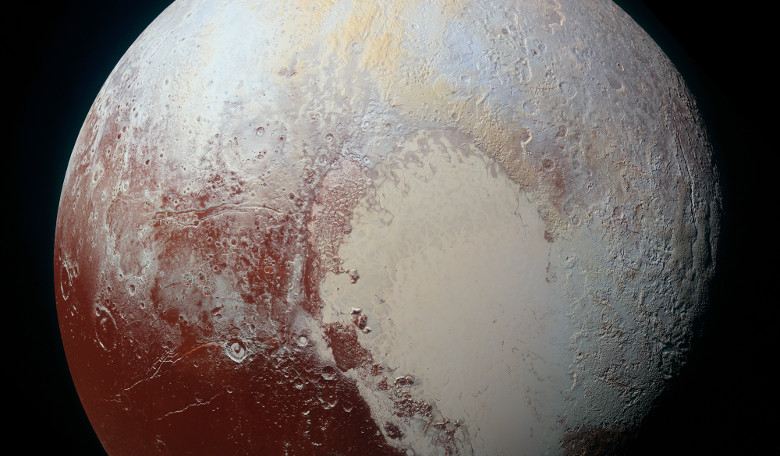When NASA’s New Horizons spacecraft got up close to Pluto in 2015, our view of this dwarf planet was transformed from an icy little oddball to a fascinating entity with a big heart stamped on its side. This captivating feature, now officially known as the Tombaugh Region (Pluto's 'Heart’), became all the more interesting when signs that the ~1,000-kilometre-wide basin on the western half, was hiding a huge subsurface ocean sloshing around under its frozen shell.
However, this shell has all the hallmarks of being quite thin and as Pluto is so far from the Sun, questions were raised as to why the ocean hadn’t frozen solid after eons traversing the frigid expanse of outer space. Now, new research suggests that a thin layer of ice-trapped gas molecules at the base of Pluto’s ice shell may be enough to insulate the ocean beneath and stop it from freezing.
Sputnik Planitia, the half of Pluto’s heart that possible contains a substantial body of water underneath it, is a topographically low depression which lies mostly in the northern hemisphere, but extends across the equator. This combination of characteristics – a sunken feature in an equatorial bulge region – means that Sputnik Planitia has what is called a positive gravity anomaly. Put simply, this means that the area has more gravity than predicted by models of the dwarf planet. One way to contribute to the gravity would be to stick something large underground, say like an ocean for example and this is exactly what many scientists think is the case for this region on Pluto.
But with this theory comes problems; mainly the how has is not frozen by now problem. The presence of an ocean underneath Pluto’s heart suggests a ‘warm,’ (I.e not completely frozen) planet, and one thing is for certain, Pluto is not thought of as warm. Given the nature of the dwarf planet’s orbit around the Sun – its high inclination and its eccentricity – Pluto does not undergo much to-ing and fro-ing with other planets in order to create heating through tidal forces. Nor does the decay from one radioactive element to another provide sufficient interior heating either. So how does the ocean keep from freezing?
A thin layer of trapped methane molecules should do the trick say a team of US and Japanese researchers whose lead author on the research paper recently submitted to Nature Geoscience, is Shunichi Kamata based at Hokkaido University, Sapporo, Japan.
The trapped molecules official name are clathrate hydrates. Clathrate hydrates or gas hydrates are molecules of gas that are locked in a lattice of water ice molecules that are linked together through hydrogen-bonding. Clathrates have been found to occur naturally in large quantities and on Earth, around 6.4 trillion tonnes of methane is trapped in deposits of methane clathrate on the deep ocean floor.
However, this is the frigid environment of Pluto we are talking about, not an ambient Earth. Be that as it may, clathrates should form relatively easy as natural gas clathrate hydrates are known to remain in the solid state well above the 273.15 K (0°C) melting point of pure water. They also form well under pressure too - something an overlying frozen surface would be able to provide. As such a freezing ocean would form clathrate hydrates rather than water ice if dissolved gas concentrations are sufficiently high, say the team.
With a layer a few to 10 kilometres in thickness of clathrate hydrates at the base of Pluto’s ice shell, the team then modelled what effects this veneer of encased gas would have on the planet’s temperature and ice shell thickness over time. Their results, say the team, suggest that this cap of caged molecules would act as a highly viscous thermal insulator between a subsurface ocean and an ice shell to keep the ocean from freezing. It would also maintain thickness variations in the ice say Kamata and colleagues.
What’s more the gas in the hydrates is most likely methane, and not nitrogen, which is what Sputnik Planitia is thought to be composed of. These molecules once released, then escape to help fill up Pluto’s atmosphere. This methane may come from the comet-like material that formed Pluto, chemical reactions in Pluto’s rocky core, or a combination of both. The research could also help explain why similar oceans on other icy planetary bodies, such as Europa and Enceladus, keep from freezing too conclude the team.











